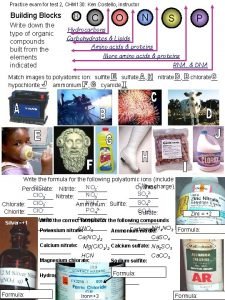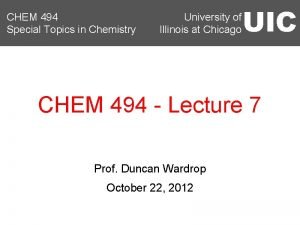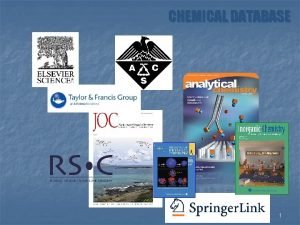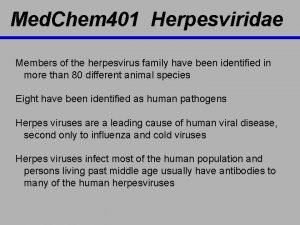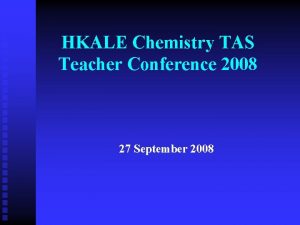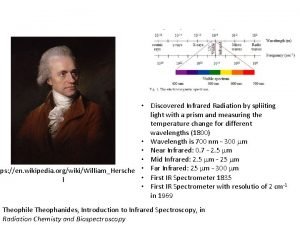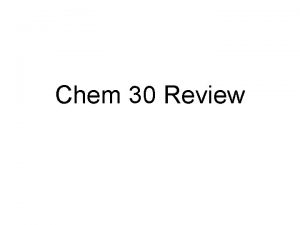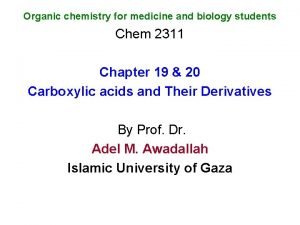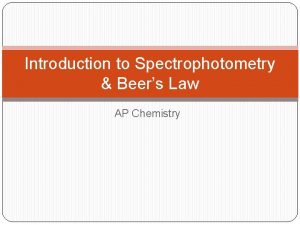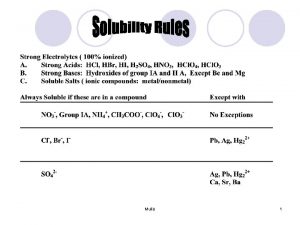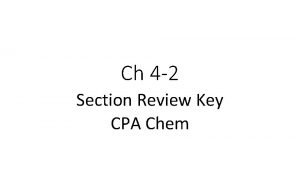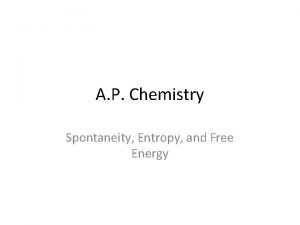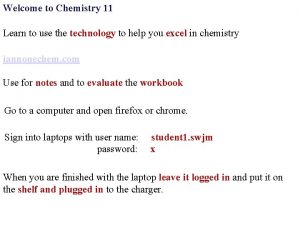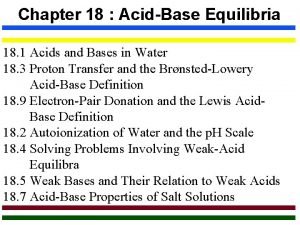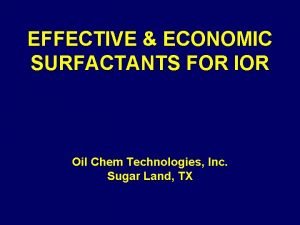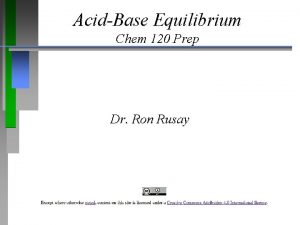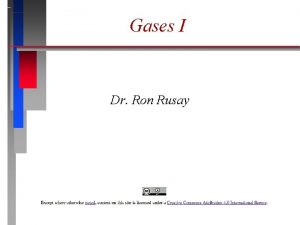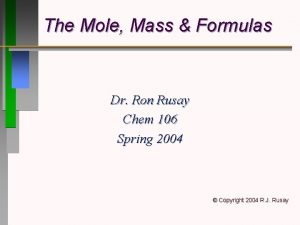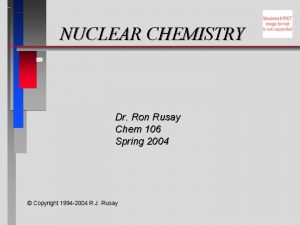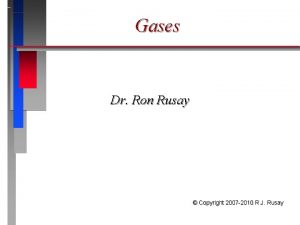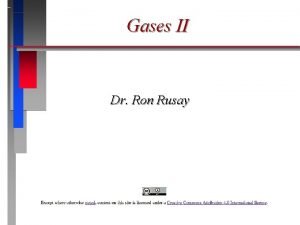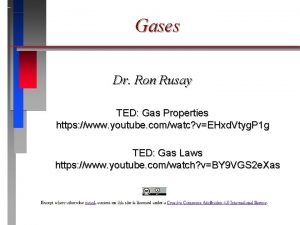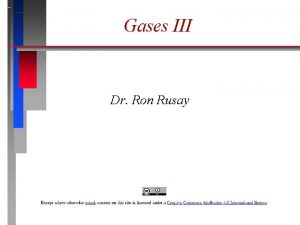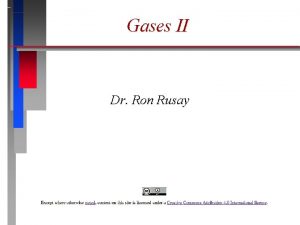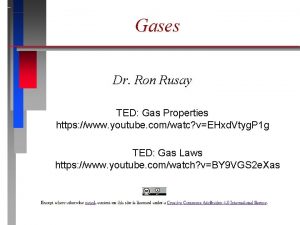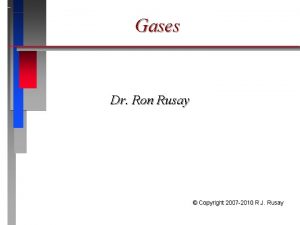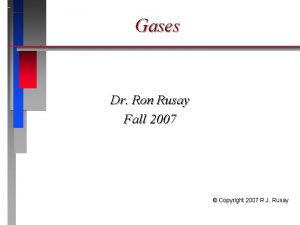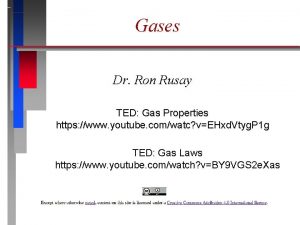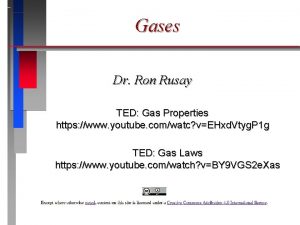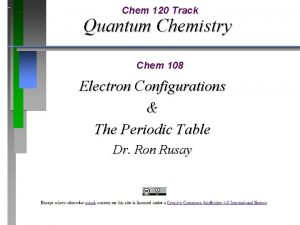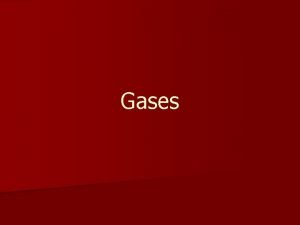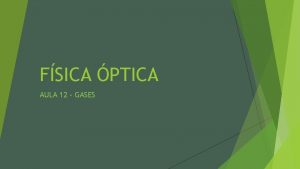Gases Chem 120 Prep Dr Ron Rusay Do






















- Slides: 22

Gases Chem 120 Prep Dr. Ron Rusay

Do you have enough oxygen to climb Mt. Everest? http: //chemconnections. org/chemwiki/everest. htm

QUESTION Typical total volume for human lungs is approximately 5, 800 m. L. At a temperature of 37°C (average body temperature) and pressure of 0. 98 atm, how many theoretical number of moles of air can we carry inside our lungs? (R = 0. 08206 L atm/ K mol) A) B) C) D) E) 1. 9 mol 0. 22 mol 230 mol 2. 20 mol: Moles can harm a person’s lungs.

ANSWER B) The units for temperature must be in K, pressure in atm, and volume in L. Then using the universal constant 0. 08206 L atm/ K mol : n air = PV / RT n air = 0. 98 atm x 5. 800 L / (37 + 273) K x 0. 08206 L * atm/ K mol n air = 0. 22 mol

An average pair of human lungs actually contains only about 3. 5 L of air after inhalation and about 3. 0 L after exhalation. Assuming that air in your lungs is at 37°C and 1. 0 atm and there is 20. 9% oxygen in air. (R = 0. 08206 L atm/ K mol) 1) How many moles of O 2 are actually in a typical breath? . 2) What is the mass of O 2 in a typical breath? . 3) How much of the O 2 is essential biochemically?

QUESTION An average pair of human lungs actually contains only about 3. 5 L of air after inhalation and about 3. 0 L after exhalation. Assuming that air in your lungs is at 37°C and 1. 0 atm and there is 20. 9% oxygen in air. (R = 0. 08206 L atm/ K mol) How many moles of oxygen are actually in a typical breath? A) B) C) D) E) 0. 0020 mol 0. 030 mol 0. 025 mol 0. 0041 mol

An average pair of human lungs actually contains only about 3. 5 L of air after inhalation and about 3. 0 L after exhalation. Assuming that air in your lungs is at 37°C and 1. 0 atm and there is 20. 9% oxygen in air. How many moles of O 2 are actually in a typical breath? . n O (g) = (20. 9%) * PV / RT n O (g) = (0. 209 mol O (g) / mol air) x 1. 0 atm x (3. 5 L-3. 0 L) / 2 2 2 0. 08206 L * atm x 310 K) n O (g) = 0. 0041 mol 2

ANSWER An average pair of human lungs actually contains only about 3. 5 L of air after inhalation and about 3. 0 L after exhalation. Assuming that air in your lungs is at 37°C and 1. 0 atm. (R = 0. 08206 L atm/ K mol) How many moles of air are actually in a typical breath? A) B) C) D) E) 0. 0020 mol 0. 020 mol air 0. 030 mol 0. 025 mol 0. 0041 mol oxygen n air (g) = PV / RT n O (g) = (20. 9%) * PV / RT 2

QUESTION An average pair of human lungs actually contains only about 3. 5 L of air after inhalation and about 3. 0 L after exhalation. Assuming that air in your lungs is at 37°C and 1. 0 atm and there is 20. 9% oxygen in air: What is the mass of O 2 in a typical breath? A) 0. 0041 mol x 16 g/mol B) 0. 020 mol x 16 g/mol C) 0. 0041 mol x 32 g/mol D) 0. 020 mol x 32 g/mol

An average pair of human lungs actually contains only about 3. 5 L of air after inhalation and about 3. 0 L after exhalation. Assuming that air in your lungs is at 37°C and 1. 0 atm and there is 20. 9% oxygen in air. What is the mass of O 2 in a typical breath? . n O (g) = (20. 9%) * PV / RT n O (g) = (0. 209 mol O (g) / mol air) (1. 0 atm x (3. 5 L-3. 0 L) x 2 2 2 mol air * K / 0. 0821 L * atm x 300 K) n O (g) = 0. 0041 mol 2 g O (g) = 0. 0041 mol x 32. 0 g/mol 2 g O 2(g) = 0. 13 g

An average pair of human lungs actually contains only about 3. 5 L of air after inhalation and about 3. 0 L after exhalation. Assuming that air in your lungs is at 37°C and 1. 0 atm How much of the O 2 is essential biochemically? Two estimates for a person with normal physical activity range from 0. 67 - 0. 84 kg of O 2 being used per day (NASA provided the higher value). How many breaths do you take in one day? ~ 5 mol % of the O 2 is actually used per breath. Hard exercise increases this oxygen demand (intake) about 10 fold.

QUESTION The primary source of exhaled CO 2 is from the combustion of glucose, C 6 H 12 O 6 (molar mass = 180. g/mol. ). The balanced equation is shown here: C 6 H 12 O 6 (aq) + 6 O 2 (g) 6 CO 2 (g) + 6 H 2 O (l) If you oxidized 5. 42 grams of C 6 H 12 O 6 while tying your boots to climb Mt. Everest, how many liters of O 2 @ STP conditions did you use? (R = 0. 08206 L atm/ K mol) A) B) C) D) 0. 737 L 0. 672 L 4. 05 L 22. 4 L

ANSWER C) 4. 05 L C 6 H 12 O 6 (aq) + 6 O 2 (g) 6 CO 2 (g) + 6 H 2 O (l) The number of moles of glucose must first be determined (5. 42 g/180. g/mol = 0. 0301 moles), then this is multiplied by 6 to account for the stoichiometric ratio between glucose and oxygen. From this, V = n. RT/P is used with the appropriate substitutions. (R = 0. 08206 L atm/ K mol) = 6 x 0. 0301 mol O 2(g) x 0. 08206 L * atm mol-1 x 273 K/ 1 atm)

Molar Mass of a Gas PV = n RT ð n = g of gas/ MM gas [MM gas = g/mol] ð PV = (g of gas/ MM gas)RT ð MM gas = g of gas/V (RT/P) ð Density of gas = g of gas/V [experimental] ð MM gas = density of gas (RT/P)

QUESTION Freon-12, CF 2 Cl 2, a “safe” compressible gas, was widely used from 1935 -1994 as a refrigerant in refrigerators, freezers, and air conditioning systems. However, it had been shown to be a greenhouse gas and to catalytically destroy the ozone layer. It was phased out and banned. 200 ml of Freon-12 was collected by syringe. It weighed 0. 927 grams, had a temperature of 30. 0°C, and a pressure of 698. 2 mm of Hg. What is the experimental molar mass of Freon-12? (R = 0. 08206 L atm/ K mol) A. B. C. D. E. 12. 1 g/mol 84 g/mol 92. 7 g/mol 115 g/mol 121 g/mol

ANSWER E) MM gas = density of gas (RT/P) MM gas = 0. 927 g/ 0. 200 L x 0. 08206 L atm mol x 303 K / 698. 2 mm Hg / 760 mm Hg/ 1 atm

QUESTION The density of an unknown atmospheric gas pollutant was experimentally determined to be 1. 964 g/ L @ 0 o. C and 760 torr. • What is the molar mass of the gas? • What might the gas be? A) CO B) SO 2 C) H 2 O D) CO 2

ANSWER CO (28 g/mol) SO 2 (62 g/mol) H 2 O (18 g/mol) CO 2 (44 g/mol) 1. 964 g/ L @ 0 o. C and 760 torr. R = 0. 08206 L atm mol o. C K torr atm MM gas = density of gas (RT/P) MM gas = 1. 964 g/ L x 0. 08206 L atm mol x 273 K/ 760 torr x 760 torr/ 1 atm MM MMgas gas==44. 0 g/mol D) CO 2

QUESTION 0. 0820 grams of the volatile, gaseous phase, of a compound, which smells like fresh raspberries, was trapped in a syringe. It had a volume of 12. 2 m. L at 1. 00 atmosphere of pressure and 25. 0°C. What is the molar mass of this pleasant smelling compound ? A) B) C) D) 13. 8 g/mol 164 g/mol 40. 9 g/mol 224 g/mol

ANSWER B) 164 g/mol Using PV = n. RT : 0. 0122 L for V, 298 K for T, 0. 08206 for R and solving for n the number of moles represented by 0. 0820 grams can be obtained. Then the MOLAR MASS (grams in one mole) can be determined. MM gas = density of gas (RT/P) MM gas = 0. 0820 g/ L x 0. 00122 L x 0. 0821 atm mol x 298 K/ 1 atm

QUESTION For the compound that smells like fresh raspberries, the following structure, C 10 H 12 O 2, matches its calculated molar mass. A) TRUE B) FALSE

ANSWER Based on your answers for the compound, which smells like fresh raspberries, in the previous two questions, the following structure matches its molecular formula. A) TRUE B) FALSE 164 g/mol = C 10 H 12 O 2
 Rusay
Rusay 120px x 120px
120px x 120px 160+140
160+140 Kinetics ap chemistry
Kinetics ap chemistry Chem 130 final exam
Chem 130 final exam Chem 494
Chem 494 Chem commun impact factor
Chem commun impact factor Chem 260 umich
Chem 260 umich Chem 401
Chem 401 Quickfit apparatus
Quickfit apparatus Gen chem
Gen chem Chem libretext
Chem libretext Chem 30 data booklet
Chem 30 data booklet Chem
Chem Beer's law formula
Beer's law formula Chem quiz.net
Chem quiz.net Cpa chem
Cpa chem Ap chemistry entropy and free energy
Ap chemistry entropy and free energy Iannone chem moodle
Iannone chem moodle Lacl3
Lacl3 The formula for the hydronium ion is _____. ho3 h3o+ h+ oh-
The formula for the hydronium ion is _____. ho3 h3o+ h+ oh- Chem
Chem Sugar ior
Sugar ior




